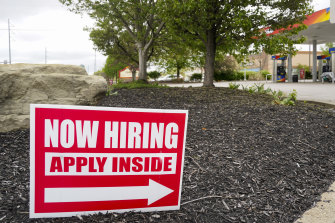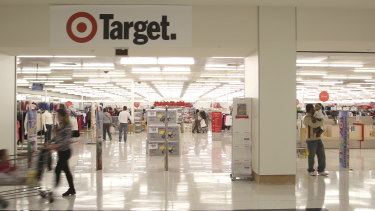For our free coronavirus pandemic coverage, learn more here.
Washington: During the early days of the coronavirus pandemic, Deborah, a 26-year-old architect in New York City, was petrified about losing her job. As business dried up at the firm where she worked, her bosses enacted two sweeping redundancy rounds. She feared she could be next to go.
“Our office laid off a lot of people,” she says. “I was terrified of being fired for so long.”
While she liked her job, Deborah, who prefers to be known only by her first name, had been thinking about making a career change before the pandemic hit. But with so much uncertainty in the world, it didn’t seem like a smart time to be making any big moves.
Americans are quitting their jobs in droves.Credit:AP
Then, as the COVID-19 vaccines started rolling out and life began returning to normal over the northern summer, she started job-hunting and was delighted by what she found. “When I started looking, there were definitely opportunities,” she says. “I felt I could take time to hunt for the right move.”
In late October, she resigned from her job to take up a new role at another architecture firm in New York. Among the perks was an almost 30 per cent increase in salary, a rise she did not think achievable so early in her career.
Deborah is part of a phenomenon known as the “great resignation” – an unprecedented wave of Americans who have quit their jobs in recent months.
New figures released on Saturday (AEST) show that a record 4.4 million Americans – three per cent of the national workforce – voluntarily quit their jobs in September. This followed 4.3 million workers who walked out the previous month.
In total, almost 35 million Americans have resigned from their jobs this year – also an all-time high.
“This is a moment of empowerment for workers,” says Anthony Klotz, the Texas A&M University management professor who coined the term “great resignation”. Klotz first predicted the imminent deluge of people voluntarily quitting in a May interview with Bloomberg.
Klotz, an expert in the psychology of workplace resignations, says there were four reasons he saw the trend coming.
First, there was a backlog of resignations in the economy. Because workers were worried about making significant changes during a pandemic, people may otherwise have quit decided to stay put.
Major US retailers such as Target have offered to pay for their workers’ college tuition to attract and retain staff. Credit:Bloomberg
Secondly, Klotz points to burnout – an issue he says particularly affected workers in the retail, hospitality and healthcare sectors. As well as working stressful, front-line roles during a pandemic, parents also had to juggle work with at-home schooling for their children.
These workers were desperate for a break. And because many had saved money during the pandemic, thanks to government stimulus cheques and reduced spending, it was something they could consider taking.
Then there were the psychological factors. Klotz says many people experienced “pandemic epiphanies” about their careers during enforced time at home.
“When individuals are close to death or illness, we tend to take a step back and take stock of our own lives,” Klotz says. “We ask ourselves: am I living life the way I want to live it? Lockdown gave people a lot of time to reflect and plan if they wanted to do something different with their career.”
Almost 35 million Americans have packed up and left their jobs this year – an all-time high.Credit:Tribune
There’s a particularly American element to this trend, he says. “In the US work is very central to our identity. People started to ask: is working giving me back as much as I’m giving it?”
Finally, there was the move to remote work. “Working from home was a tough adjustment at first but then many people did not want to go back to the office,” he says. “People don’t tend to give up freedom willingly. So when it came time to go back to the office, some people said no.”
The latest Bureau of Labour Statistics figures show there are currently a whopping 10.5 million job openings in the US. The labour shortage has given workers the power to demand higher wages and more impressive benefits – as long as they are willing to change jobs.
It’s a major turnaround in America where salaries and conditions – especially for blue-collar jobs in retail, fast food and hospitality – have tended to be far less generous than in comparable developed countries such as Australia.
Australian-born restaurateur Nick Mathers is battling the US labour shortage.
The flip side of the current moment of worker empowerment is that many business owners are struggling to find enough staff.
Among those affected is Sydney-born restaurateur Nick Mathers, who operates a series of popular restaurants and cafes in New York, Las Vegas and California.
Mathers recently opened a 10,000-square-foot Hawaiian restaurant in Los Angeles, but is keeping a fifth of the restaurant closed because he cannot find enough staff to open at full capacity.
“It’s sitting there stagnant and that’s frustrating,” he says. “We are 15 to 20 people short of where we need to be. And it’s not through lack of trying or underpaying people; we overpay.”
The change from the pre-pandemic hiring market to now has been dramatic, Mathers says.
“Two years ago, we were being inundated with staff,” he says. “I used to get 30 applicants for a certain role, now we get two or three. To find kitchen labour, runners, bussers is extraordinarily difficult – anything in a lower-level labour category.”
He adds: “It’s a competitive market right now. We’re asking, ‘How do you make yourself a place people want to work?’”
Hourly pay rose in the US by an impressive 4.6 per cent in the year to September – though the gains have been wiped out by an even bigger increase in inflation. Major corporations are pulling out the stops to attract and retain workers.
Walmart and Target, two of America’s largest retailers, recently announced they would pay for full tuition fees and textbooks at select colleges for its US workers. This week, Ikea announced it was raising its starting wage to $US16 an hour – up from the average starting hourly wage of $US14.79.
Crowdfunding platform Kickstarter is experimenting with a four-day workweek next year, paying employees the same salary to work fewer days. Other companies are offering enhanced parental leave and work-from-home arrangements to lure employees.
Although he saw it coming, Klotz admits he does not know how long America’s “great resignation” will last.
“The question of the day is: is this an inflection point, meaning workers have had enough and are going to continue to demand more? Or is it just a blip and things will go back to normal?”
For now at least, the trend shows no signs of letting up.
Get a note directly from our foreign correspondents on what’s making headlines around the world. Sign up for the weekly What in the World newsletter here.
Most Viewed in World
From our partners
Source: Read Full Article






